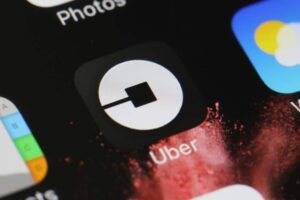 The news that US-based ride-sharing service Uber has finally settled on a new CEO to replace departed CEO Travis Kalanick should, on paper, begin to calm analysts who wonder if a company beset by controversy and still yet to turn a profit can yet right the ship and become the global force for transforming consumer transportation that it was meant to be. One of the first steps to recovery will be to rebuild relationships with skeptical customers inclined to give perennial also-ran Lyft a second look. With a loyalty partnership with Visa now expanding nationwide, the company is taking baby steps toward rebuilding those relationships – but will these steps be enough?
The news that US-based ride-sharing service Uber has finally settled on a new CEO to replace departed CEO Travis Kalanick should, on paper, begin to calm analysts who wonder if a company beset by controversy and still yet to turn a profit can yet right the ship and become the global force for transforming consumer transportation that it was meant to be. One of the first steps to recovery will be to rebuild relationships with skeptical customers inclined to give perennial also-ran Lyft a second look. With a loyalty partnership with Visa now expanding nationwide, the company is taking baby steps toward rebuilding those relationships – but will these steps be enough?
By Rick Ferguson
With the possible exception of Volkswagen, few companies have suffered more from a continual run of self-inflicted PR disasters as has Uber Technologies Inc. The company’s hard-charging, take-no-prisoners corporate culture – embodied by its disgraced former CEO Kalanick – is arguably what made it the global leader in ride-sharing in the first place. That same corporate culture may also be its undoing. Only a concerted and sustained effort by new CEO Dara Khosrowshahi to transform that culture and rebuild damaged customer relationships may prevent the company from becoming a cautionary tale.
Still, can any CEO overcome the fallout from Uber’s transgressions? The list of the company’s misdeeds ranges from sexual harassment, to alleged technology theft and patent violations, to short-changing drivers, to willfully violating local regulations, to leasing defective vehicles to its drivers. Just last week, the Wall Street Journal reported that the Justice Department is investigating the company for possibly violating U.S. law by bribing foreign officials.
The missteps have had a quantifiable effect on Uber’s market share: Since June 2015, Uber’s U.S. market share has declined from 90 percent to 75 percent, while other sources estimate that Lyft’s share may have grown to 30 percent this year, resulting in another impressive round of funding and a market cap of over $7 billion.
The momentum, then, would seem to be all on Lyft’s side. Here’s a pair of money quotes from Fortune contributor Michal Lev-Ram, who sees two primary reasons why Lyft could emerge triumphant. First, Lyft seems to understand, much better than Uber does, that customer loyalty begins with employee loyalty:
“Whether or not Lyft has ridden Uber’s coattails, it has definitely picked fewer battles—including with its 700,000 drivers. Like Uber, Lyft has been the subject of class-action lawsuits brought by drivers who sought to be classified as employees, not independent contractors. But recent surveys show that Lyft’s drivers are happier with their experience than Uber’s. It’s not surprising. While Uber’s Kalanick was caught on camera berating a driver in a video that went viral, Lyft’s fist-bump ethos has long nudged customers to see drivers as peers rather than chauffeurs—let alone punching bags. Notably, Lyft drivers also make more money, on average, and the company has enabled “in-app” tipping since its launch. Uber, meanwhile, only got around to offering a gratuity-giving feature this summer.”
Contrast that attitude with Kalanick’s infamous browbeating of an Uber driver caught on video, and we can see how happier Lyft drivers might make a difference. With both companies charging full speed into autonomous vehicle development, however, how long will drivers matter? That question brings us to Lev-Ram’s second point, which is that the eventual evolution to driverless vehicles will require the winner to focus relentlessly on the customer experience:
“…one compelling ingredient [Lyft does] discuss is the technological equivalent of its pink mustache—a user interface aimed at making the experience of being ‘robo-driven’ friendlier, by showing passengers what the car’s sensors are ‘seeing’ and ‘thinking.’ In addition to a screen that will show real-time footage from the car’s cameras, the system will include a voice function that explains what the vehicle is doing and why. (Imagine a soothing, conversational voice telling you, ‘Hey, I see a bike.’) Obvious as that may sound, Lyft’s hope is that it can humanize the car and let passengers peer inside its mind."
“Lyft execs believe this focus on user experience could help it push ahead of Uber. All things considered, Uber and Lyft are equally reliable and charge customers identical prices, Zimmer notes, ‘So now it’s all about the brand and experience.’ Put in terms Zimmer loves best: Imagine you’re on a sidewalk in New York and two hotels are the same distance from you and the same price. Which do you choose? Maybe the one that gives you fist bumps?”
Does Lyft, then, have the long-term edge over Uber in becoming the most trusted brand in ride-sharing? Lyft seems to understand better than Uber that marketplace parity requires a sustained effort to build equity and value in your customer relationships. Uber isn’t going down without a fight, however; even as the company has suffered a contentious relationship with its drivers, it has shown a willingness to innovate in developing loyalty partnerships.
For example, its loyalty pilot test with Visa in California last year was apparently successful enough for Uber and Visa to roll it out nationwide. The program, called Visa Local Offers, allows Visa cardholders to earn Uber rider credits for shopping with local merchants. Money quote from Visa VP Terry Angelos, quoted in Chain Store Age:
“As we continue to move towards a cashless culture, programs like Visa Local Offers with Uber are representative of new ways that merchants will be able to unlock business value while also rewarding consumers in simple and seamless ways for everyday purchases. More than a quarter of Visa cardholders who used Uber, made a purchase with their Visa card at a physical store within 30 minutes of completing an Uber ride, making this program a great way for our merchant partners to engage new and existing customers while also offering consumers secure, simple and consistent purchasing experiences.”
With its market share, ubiquity, deep war chest, and continued loyalty innovation, Uber probably can’t be counted out just yet. The battle for consumer loyalty between these two ride-hailing rivals promises to be a riveting one – and we’ll all be choosing sides when we pull out our phones to hail that next ride to get us home or to the airport. May the best brand win.
Rick Ferguson is Editor in Chief of the Wise Marketer Group.




